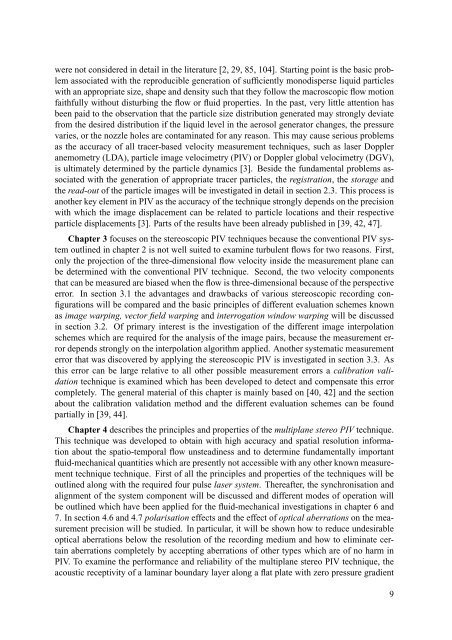The significance of coherent flow structures for the turbulent mixing ...
The significance of coherent flow structures for the turbulent mixing ...
The significance of coherent flow structures for the turbulent mixing ...
Create successful ePaper yourself
Turn your PDF publications into a flip-book with our unique Google optimized e-Paper software.
were not considered in detail in <strong>the</strong> literature [2, 29, 85, 104]. Starting point is <strong>the</strong> basic problem<br />
associated with <strong>the</strong> reproducible generation <strong>of</strong> sufficiently monodisperse liquid particles<br />
with an appropriate size, shape and density such that <strong>the</strong>y follow <strong>the</strong> macroscopic <strong>flow</strong> motion<br />
faithfully without disturbing <strong>the</strong> <strong>flow</strong> or fluid properties. In <strong>the</strong> past, very little attention has<br />
been paid to <strong>the</strong> observation that <strong>the</strong> particle size distribution generated may strongly deviate<br />
from <strong>the</strong> desired distribution if <strong>the</strong> liquid level in <strong>the</strong> aerosol generator changes, <strong>the</strong> pressure<br />
varies, or <strong>the</strong> nozzle holes are contaminated <strong>for</strong> any reason. This may cause serious problems<br />
as <strong>the</strong> accuracy <strong>of</strong> all tracer-based velocity measurement techniques, such as laser Doppler<br />
anemometry (LDA), particle image velocimetry (PIV) or Doppler global velocimetry (DGV),<br />
is ultimately determined by <strong>the</strong> particle dynamics [3]. Beside <strong>the</strong> fundamental problems associated<br />
with <strong>the</strong> generation <strong>of</strong> appropriate tracer particles, <strong>the</strong> registration, <strong>the</strong> storage and<br />
<strong>the</strong> read-out <strong>of</strong> <strong>the</strong> particle images will be investigated in detail in section 2.3. This process is<br />
ano<strong>the</strong>r key element in PIV as <strong>the</strong> accuracy <strong>of</strong> <strong>the</strong> technique strongly depends on <strong>the</strong> precision<br />
with which <strong>the</strong> image displacement can be related to particle locations and <strong>the</strong>ir respective<br />
particle displacements [3]. Parts <strong>of</strong> <strong>the</strong> results have been already published in [39, 42, 47].<br />
Chapter 3 focuses on <strong>the</strong> stereoscopic PIV techniques because <strong>the</strong> conventional PIV system<br />
outlined in chapter 2 is not well suited to examine <strong>turbulent</strong> <strong>flow</strong>s <strong>for</strong> two reasons. First,<br />
only <strong>the</strong> projection <strong>of</strong> <strong>the</strong> three-dimensional <strong>flow</strong> velocity inside <strong>the</strong> measurement plane can<br />
be determined with <strong>the</strong> conventional PIV technique. Second, <strong>the</strong> two velocity components<br />
that can be measured are biased when <strong>the</strong> <strong>flow</strong> is three-dimensional because <strong>of</strong> <strong>the</strong> perspective<br />
error. In section 3.1 <strong>the</strong> advantages and drawbacks <strong>of</strong> various stereoscopic recording configurations<br />
will be compared and <strong>the</strong> basic principles <strong>of</strong> different evaluation schemes known<br />
as image warping, vector field warping and interrogation window warping will be discussed<br />
in section 3.2. Of primary interest is <strong>the</strong> investigation <strong>of</strong> <strong>the</strong> different image interpolation<br />
schemes which are required <strong>for</strong> <strong>the</strong> analysis <strong>of</strong> <strong>the</strong> image pairs, because <strong>the</strong> measurement error<br />
depends strongly on <strong>the</strong> interpolation algorithm applied. Ano<strong>the</strong>r systematic measurement<br />
error that was discovered by applying <strong>the</strong> stereoscopic PIV is investigated in section 3.3. As<br />
this error can be large relative to all o<strong>the</strong>r possible measurement errors a calibration validation<br />
technique is examined which has been developed to detect and compensate this error<br />
completely. <strong>The</strong> general material <strong>of</strong> this chapter is mainly based on [40, 42] and <strong>the</strong> section<br />
about <strong>the</strong> calibration validation method and <strong>the</strong> different evaluation schemes can be found<br />
partially in [39, 44].<br />
Chapter 4 describes <strong>the</strong> principles and properties <strong>of</strong> <strong>the</strong> multiplane stereo PIV technique.<br />
This technique was developed to obtain with high accuracy and spatial resolution in<strong>for</strong>mation<br />
about <strong>the</strong> spatio-temporal <strong>flow</strong> unsteadiness and to determine fundamentally important<br />
fluid-mechanical quantities which are presently not accessible with any o<strong>the</strong>r known measurement<br />
technique technique. First <strong>of</strong> all <strong>the</strong> principles and properties <strong>of</strong> <strong>the</strong> techniques will be<br />
outlined along with <strong>the</strong> required four pulse laser system. <strong>The</strong>reafter, <strong>the</strong> synchronisation and<br />
alignment <strong>of</strong> <strong>the</strong> system component will be discussed and different modes <strong>of</strong> operation will<br />
be outlined which have been applied <strong>for</strong> <strong>the</strong> fluid-mechanical investigations in chapter 6 and<br />
7. In section 4.6 and 4.7 polarisation effects and <strong>the</strong> effect <strong>of</strong> optical aberrations on <strong>the</strong> measurement<br />
precision will be studied. In particular, it will be shown how to reduce undesirable<br />
optical aberrations below <strong>the</strong> resolution <strong>of</strong> <strong>the</strong> recording medium and how to eliminate certain<br />
aberrations completely by accepting aberrations <strong>of</strong> o<strong>the</strong>r types which are <strong>of</strong> no harm in<br />
PIV. To examine <strong>the</strong> per<strong>for</strong>mance and reliability <strong>of</strong> <strong>the</strong> multiplane stereo PIV technique, <strong>the</strong><br />
acoustic receptivity <strong>of</strong> a laminar boundary layer along a flat plate with zero pressure gradient<br />
9
















